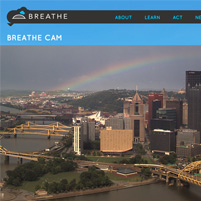Breathe Cam Lets Citizens Document Pittsburgh's Visual Air Pollution and Its Sources
Carnegie Mellon Technology Now Part of The Heinz Endowments' Breathe Project
By Byron Spice / Carnegie Mellon / 412-268-9068
John Ellis / The Heinz Endowments / 412-338-2657
 PITTSBURGH—A system of four cameras, called Breathe Cam, now keeps a constant watch on air quality over Pittsburgh, providing citizens with a new interactive tool for monitoring and documenting visual pollution in the air they breathe and even tracing it back to its sources.
PITTSBURGH—A system of four cameras, called Breathe Cam, now keeps a constant watch on air quality over Pittsburgh, providing citizens with a new interactive tool for monitoring and documenting visual pollution in the air they breathe and even tracing it back to its sources.
Funded by The Heinz Endowments as part of its Breathe Project, the camera system was developed and deployed by the CREATE Lab in Carnegie Mellon University's Robotics Institute. Anyone can access the cameras online at http://breatheproject.org/learn/breathe-cam, where images of the Downtown, East End and Mon Valley skylines are updated around the clock.
Using the interactive controls, people can zoom in on items of interest, whether it's a hovering brown cloud or individual smokestacks or coke plants. They can scan back in time to observe changes in visibility or to try to find the sources of dirty air. They also can skip back to particular dates and times that have been catalogued since the cameras were installed.
The researchers also have developed a computer vision tool to help people identify and quantify events of interest, such as releases from a smokestack. Users can correlate the visual conditions with hourly reports of fine particulate matter, ozone and other pollutant levels recorded by Allegheny County Health Department air monitoring stations.
"People can use Breathe Cam to gather visual evidence of what's happening to the air they breathe, whether it's for the entire city or for a pollution source that is a concern in their neighborhood," said Illah Nourbakhsh, professor of robotics. "With a better understanding of the dynamics of our environment, people can work more effectively to improve conditions. This isn't technology for technology's sake, but for the sake of community empowerment."
Breathe Cam includes four cameras that produce panoramic images: one atop Mount Washington's Trimont Towers; another at 625 Liberty Avenue, Downtown; one directed toward the East End from the University of Pittsburgh's Benedum Hall that was installed in October; and a camera overlooking the Mon Valley from Walnut Towers in Squirrel Hill.
"The launch of the Breathe Cam creates for Pittsburgh one of the world's most sophisticated imaging technologies for visualizing air pollution," said Grant Oliphant, president of The Heinz Endowments, which launched the Breathe Project in the fall of 2011 to improve air quality in southwestern Pennsylvania. "This powerful tool will help build public awareness about the effects of dirty air on our health and environment, while empowering people to better understand and reduce these impacts in their own communities."
The technology behind Breathe Cam is similar to the CREATE Lab's GigaPan system, which uses software to stitch together multiple photographs to create a large panorama with incredible resolution. But researchers, led by Randy Sargent and Paul Dille, have upgraded the system so people can explore the panoramas only minutes after the individual images are recorded.
"This is the first time we've had cameras that can take pictures this rapidly and do so 24/7," said Sargent, senior systems scientist. "And we no longer have to wait hours to combine the photos into panoramas. Thanks to work by Paul Dille, it takes just five or 10 minutes to process each panorama. It's enabled us to turn this into a service, not just a technology."
Though people viewing Breathe Cam via their computers can zoom in on objects of interest, the resolution isn't high enough to allow users to identify people. The researchers have taken pains not to compromise the privacy of individuals or their homes.
One computer vision tool will enable users to gather information from the cameras without constantly watching the images. The tool can be set to trigger when something of interest to the user, such as the release of smoke from a coke battery or smokestack, occurs. In addition to monitoring air pollution, the same tool can be used to detect train movement across the city.
With electronic cameras now commonplace, many individuals across the country already are using cameras to routinely monitor pollution sources. With Breathe Cam, Nourbakhsh noted, Carnegie Mellon and Heinz have developed a computer architecture for turning these camera feeds into an evidentiary system. He said work is underway to make such a system available to anyone who wants to share their camera feed with it. In addition, the Allegheny County Health Department and local environmental groups are partnering with CREATE Lab to use Breathe Cam technology in their efforts to monitor and improve air quality in the region.
###